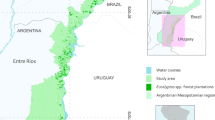Abstract
This paper reviews the findings of nine studies carried out over about the last decade by a forestry socio-economic research group in Queensland, Australia. On the basis of survey evidence and landholder typology research, the questions of who plants trees and for what reasons are addressed, and inferences are drawn about the impact of land fragmentation on farm forestry. It is concluded that forestry is less popular on the larger and commercially viable farms than on smaller holdings of similar land type, and plantation establishment is often supported by off-farm income, so that farm fragmentation may actually lead to increased tree planting. However, whether this would lead to increased timber production is less clear, because of the strong interest of people on small holdings in environmental plantings and because of difficulties in marketing small quantities of the variable quality timber from mixed-species plantings. Also, the quality of silviculture appears to be positively correlated with area planted. Some implications are drawn for land-use policy.
Similar content being viewed by others
References
Creighton, C. and Sexton, G. (1996), ‘Community Rainforest Reforestation Program — a farm forestry demonstration’, in A. Grodecki, J. Aitchison and P. Grimbeek, Managing and Growing Trees Training Conference, 8–10 October, held in Bundaberg, Department of Natural Resources, Brisbane, Vol. 1, pp. 100–109.
Creighton, J.H., Blatner, K.A. and Baumgartner, D.M. (2004), ‘The future of Washington State family-owned forests in an increasingly fragmented landscape’, in D.M. Baumagartner, (ed.), Proceedings of Human Dimensions of Family, Farm and Community Forestry International Symposium, Washington State University, Pullman, WA, USA, 29 March — 1 April 2004, Washington State University Extension MISC0526, pp. 51–55.
CRRP Management Committee (1993), Community Rainforest Reforestation Program: Sowing the Seeds for a Future Wet Tropics Timber Industry, Queensland Department of Primary Industries Forest Service, Brisbane.
Emtage, N.F., Harrison, S.R. and Herbohn, J.L. (2001), ‘Landholder attitudes to and participation in farm forestry activities in sub-tropical and tropical Eastern Australia’, in S.R. Harrison and J.L. Herbohn (eds), Tropical Small-scale Forestry: Social and Economic Analysis and Policy, Edward Elgar, Cheltenham, pp. 195–210.
Emtage, N.F. (1995), Landholders’ Perceptions of Planting and Managing Trees, B.App. Sci. Hons. thesis, Southern Cross University, Lismore NSW.
Emtage, N.F. and Specht, A. (1998), Landholders’ Perceptions of Farm Forestry in the Northern Rivers Region of New South Wales: Overview Report, report to the Northern Rivers Regional Plantation Committee, Lismore NSW.
Eono, J-C. and Harrison, S.R. (1996a), ‘Report on non-timber benefits of rainforest reforestation’, Annual Conference of the Cooperative Research Centre for Tropical Rainforest Ecology and Management, Kuranda, Queensland: Cooperative Research Centre for Tropical Rainforest Ecology and Management.
Eono, J-C. and Harrison, S.R. (1996b), ‘Local Government and Landholder Perceptions of the Benefits of Planting Rainforest Tree Species in the Queensland Wet Tropics’, in A. Keto, (ed.) World Heritage Tropical Forests Conference: Handbook and Abstracts, Cairns: Australian Rainforest Conservation Society: 8.
Eono, J-C. and Harrison, S.R. (2002), ‘Estimation of costs and benefits of the community rainforest reforestation program in North Queensland’, Economic Analysis and Policy, 32(2): 69–89.
Erskine, P.D., Lamb, D. and Bristow, M. (eds) (2005), Reforestation in the Tropics and Subtropics of Australia using Rainforest Tree Species, Rural Industries Research and Development Corporation and the Rainforest CRC, Canberra.
Harrison, S.R., Eono, J-C., Herbohn, J.L. and Sharma, P. (1996), ‘Attitudes to tree planting and assistance schemes by Queensland landholders’, in A. Grodecki (ed.), Managing and Growing Trees on Farms, Vol 1, Greening Australia Queensland, Brisbane, pp. 127–136.
Harrison, S.R., Miamo, J. and Anderson, M.W. (1999), ‘Government and private sector joint venturing in natural resource development: The Queensland forestry joint venture scheme plantation’, Economic Analysis and Policy, 29(1): 15–29.
Harrison, S.R., Herbohn, J.L., Emtage, N.F. and Smorfitt, D.B. (2001), ‘Landholder attitudes to forestry incentive schemes in North Queensland’, in A. Grodecki (eds), Managing and Growing Trees: Farm Forestry and Vegetation Management, Kooralbyn, 19–21 October 1998, Department of Natural Resources and Greening Australia, Brisbane, pp. 406–411.
Harrison, R., Harrison, S.R. and Herbohn, J.L. (2004), ‘Evaluation of the performance of the Community Rainforest Reforestation Program in North Queensland, Australia’, Small-scale Forest Economics, Management and Policy, 3(3): 411–429.
Herbohn, J.L., Harrison, S.R., Emtage, N.F. and Smorfitt, D.B. (1998), ‘Attitudes of landholders to farm forestry in North Queensland and the implications for policy development’, Integration Environmental Values into Small Scale Forestry, IUFRO Symposium, Vancouver, 16–20 August 1998.
Herbohn, J.L., Harrison, S.R., Ross, H. and Slaughter, G. (2003), ‘A framework for assessing the social, economic and environmental impacts of different forestry systems in North Queensland’, IUFRO Working Group 6.11.02 Forestry and Rural Development in Developed Countries, International Symposium on Forestry and Rural Development in Developed Countries: Policies, Programs and Impacts, Rotarua, New Zealand, 10–13 March.
Herbohn, J.L. and Harrison, S.R. (2004), ‘The evolving nature of small-scale private forestry in Australia’, Journal of Forestry 102(1): 42–47.
Herbohn, J.L., Emtage, N.F., Harrison, S.R. and Smorftt, D.B. (2005), ‘Attitudes of landholders to farm forestry in tropical eastern Australia’, Australian Forestry, Vol. 68(1): 50–58.
Jeffreys, I. (2003), ‘The use of compensatory and non-compensatory multi-criteria analysis in small-scale forestry’, Small-scale Forest Economics, Management and Policy, 3(1): 99–117.
Jeffreys, I. (in process), ‘A Multi-Objective Decision Support System (MODSS) with Stakeholders and Experts in the Atherton Tablelands’, Ch. 10 in Application of Multiple Objective Decision Support Systems for Participatory Farm Forestry Evaluation, PhD dissertation, The University of Queensland, Gatton.
Maczkowiack, R., Herbohn, J.L., Emtage, N.F., Slaughter, G. and Harrison, S.R. (in press), Assessment of Agroforestry Projects in Northern Australia using the Australian Farm Forestry Financial Model, Rural Industries Research and Development Corporation Research Report Series, Canberra.
Author information
Authors and Affiliations
Rights and permissions
About this article
Cite this article
Harrison, S., Herbohn, J. Relationship between farm size and reforestation activity: evidence from Queensland studies. Small-scale Forestry 4, 471–484 (2005). https://doi.org/10.1007/s11842-005-0029-2
Issue Date:
DOI: https://doi.org/10.1007/s11842-005-0029-2




